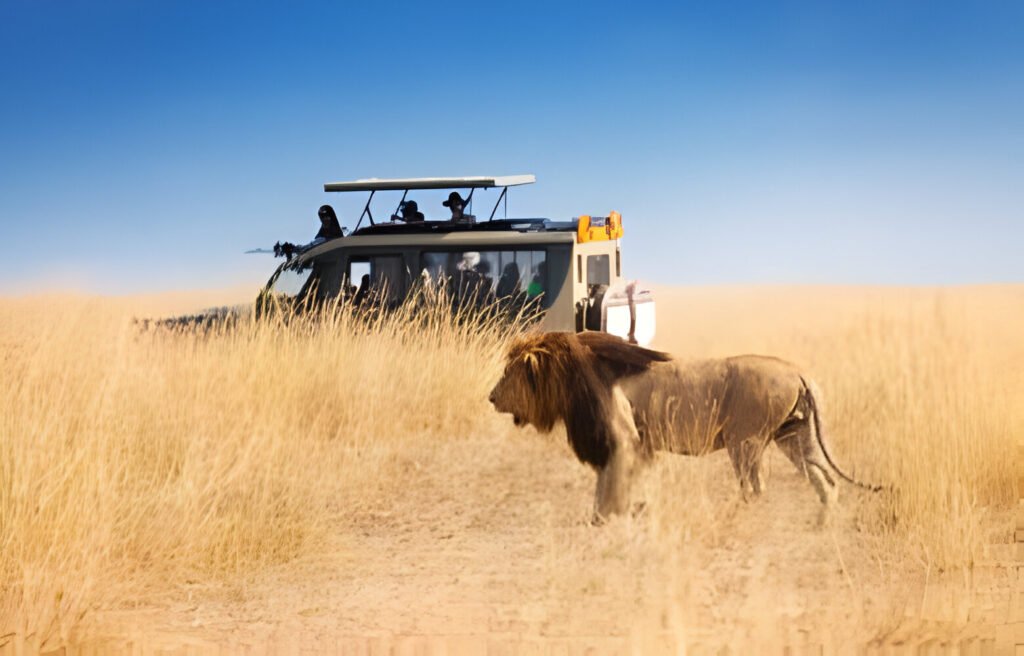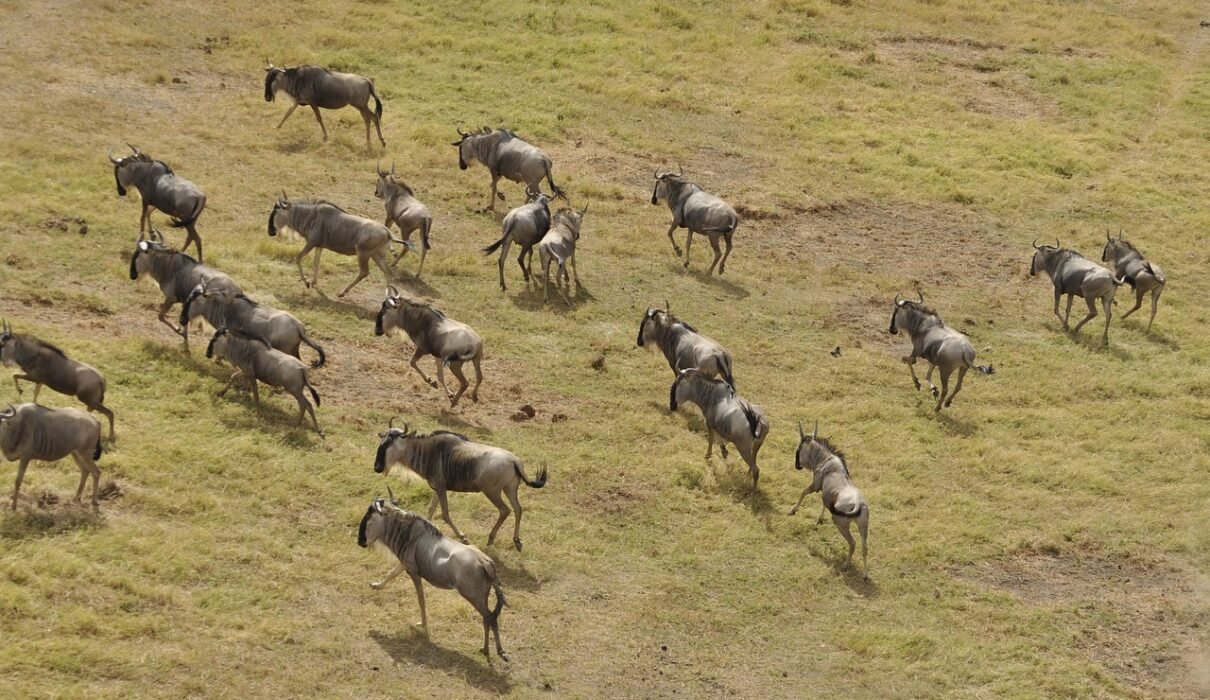What to Expect on a Game Drive in Africa. A game drive is one of the most exciting ways to experience Africa’s rich wildlife, offering close encounters with nature and unforgettable sights. Whether you’re visiting the vast plains of the Serengeti or the bushveld of Kruger National Park, a game drive brings you up close with iconic species like lions, elephants, zebras, and more. But what exactly can you expect from a game drive in Africa? This guide will walk you through what to anticipate, how to prepare, and tips for making the most of your safari adventure.

What to Expect on a Game Drive in Africa : What is a Game Drive?
A game drive is a guided tour through a wildlife reserve or national park, typically done in an open 4×4 vehicle. During the drive, expert guides and trackers take you through different ecosystems to spot animals in their natural habitats. Game drives are usually held in the early morning or late afternoon when wildlife is most active.
- Vehicles: Open-sided or open-top 4×4 vehicles allow for better visibility and an immersive safari experience.
- Guides: Trained guides share their knowledge about animal behavior, park ecosystems, and conservation efforts, enhancing your experience.
Learn more about the best game drives in Tanzania with Kilimanjaro Climb Specialist
What to Expect on a Game Drive in Africa : Types of Wildlife to Expect
Africa is known for its incredible wildlife diversity. A game drive offers the opportunity to see a wide variety of animals, from the famous Big Five to smaller creatures that are equally fascinating.
The Big Five
The term “Big Five” refers to the five most iconic animals in Africa: lion, leopard, elephant, buffalo, and rhinoceros. Spotting these majestic animals is often the highlight of any game drive.
- Lions: Look for prides resting in the shade or stalking prey during the cooler hours of the day.
- Leopards: These elusive cats are often seen lounging in trees, especially in parks like Serengeti.
- Elephants: Herds of elephants can be seen in places like Tarangire National Park, famous for its large elephant population.
- Buffalo: Often spotted in large herds, buffalo are powerful and unpredictable, adding excitement to your drive.
- Rhinos: While black and white rhinos are endangered, you can still spot them in protected areas like Ngorongoro Crater.
Spot the Big Five on your next safari with Eddy Tours Safaris
What to Expect on a Game Drive in Africa : Other Wildlife to Look For
While the Big Five are the stars, there’s much more to see:
- Zebras and Wildebeest: Especially during the Great Migration in the Serengeti, herds of zebras and wildebeest are a common sight.
- Cheetahs: Known for their speed, cheetahs can often be seen in open grasslands, hunting or lounging in the shade.
- Giraffes: Towering over the landscape, giraffes are a frequent sight, grazing on tree foliage.
- Hippos and Crocodiles: Waterholes and rivers are home to hippos and Nile crocodiles, often seen lounging or wading.
Discover more about wildlife in Tanzania’s national parks
What to Expect on a Game Drive in Africa : When is the Best Time for a Game Drive?
The timing of your game drive plays a significant role in the type of wildlife you’ll see. The best times for game drives are:
- Early Morning (6:00 AM to 9:00 AM): As the day begins, many animals are still active after a night of hunting or grazing. Predators like lions and leopards are often spotted during the cooler hours of the morning.
- Late Afternoon (4:00 PM to Sunset): In the heat of the day, most animals rest, but as temperatures cool down, they become active again. This is a prime time for spotting herbivores like zebras, giraffes, and elephants, as well as predators gearing up for the evening hunt.
The dry season (June to October) is often considered the best time for game drives, as animals gather around water sources, making them easier to spot.
Learn about the best times to visit Tanzania for game drives
What to Expect on a Game Drive in Africa : What to Bring on a Game Drive
A successful game drive requires a little preparation. Here’s a list of essentials to ensure you’re ready for the day:
- Binoculars: A must-have for spotting distant wildlife.
- Camera: Capture those unforgettable moments, whether it’s a close-up of a lion or a distant herd of elephants.
- Sunscreen and Hat: The African sun can be intense, so protect yourself from UV rays during the drive.
- Light Clothing: Wear neutral-colored, lightweight clothes that blend into the surroundings and keep you cool.
- Water: Stay hydrated, especially during long drives.
- Insect Repellent: Mosquitoes and other insects are more common in the evening, so bring repellent to stay comfortable.
Explore a detailed safari packing list here
What to Expect on a Game Drive in Africa : What Happens During a Game Drive?
A typical game drive lasts around 2 to 3 hours. Here’s what you can expect during your experience:
Briefing and Start
Your guide will give a short briefing about the day’s plan and what wildlife you might encounter. You’ll set off early in the morning or late in the afternoon, driving through different ecosystems.
Wildlife Spotting
Throughout the drive, your guide and tracker will look for signs of wildlife. This could be anything from fresh tracks to animal calls in the distance. Once a sighting is made, the vehicle will stop so you can take photos and observe the animals without disturbing them.
Learning and Engagement
Your guide will provide interesting facts about the animals, their behaviors, and the surrounding environment. This is a great opportunity to ask questions and deepen your understanding of Africa’s wildlife.
Returning to Camp
After the drive, you’ll return to your lodge or campsite, where you can relax, enjoy a meal, and share stories of the day‘s sightings.
Read more about game drive experiences
What to Expect on a Game Drive in Africa : Tips for a Great Game Drive Experience
To get the most out of your game drive, keep these tips in mind:
- Stay Silent: Noise can scare off animals, so it’s important to remain quiet during sightings.
- Be Patient: Wildlife spotting can take time. The African bush is unpredictable, and the best sightings often happen when you least expect them.
- Follow the Guide’s Instructions: Your guide knows the terrain and the animals’ behaviors, so it’s essential to listen to their advice for a safe and rewarding experience.
- Don’t Expect the Big Five: While seeing the Big Five is exciting, remember that every animal encounter is special, whether it’s a herd of elephants or a family of meerkats.
Get more safari tips from experienced guides
What to Expect on a Game Drive in Africa : Are Game Drives Safe?
Yes, game drives are generally safe when conducted by professional guides. Vehicles are designed to blend into the environment, so animals typically ignore them. Guides are trained to handle different situations and keep a safe distance from potentially dangerous animals.
- Safety Measures: Always remain seated, keep arms inside the vehicle, and follow the guide’s instructions. Never attempt to feed or touch the animals.
Read about safety tips for African safaris
Where to Go for the Best Game Drives in Africa
Africa is home to some of the world’s most renowned national parks and reserves, each offering unique wildlife experiences. Here are some top destinations:
- Serengeti National Park, Tanzania: Famous for the Great Migration and its large predator population.
- Kruger National Park, South Africa: One of Africa’s largest and oldest game reserves, offering excellent opportunities to see the Big Five.
- Maasai Mara, Kenya: Known for the Great Migration and stunning open plains.
- Chobe National Park, Botswana: Famous for its large elephant herds and river safaris.
Plan your game drive in Tanzania’s top parks with Kilimanjaro Climb Specialist

What to Expect on a Game Drive in Africa : FAQs
1. How long does a game drive last?
A typical game drive lasts between 2 to 3 hours, though some can be extended depending on the location and wildlife sightings.
2. What is the best time of day for a game drive?
The best times are early morning and late afternoon when animals are most active and the temperatures are cooler.
3. Can I take young children on a game drive?
Many safari lodges and parks offer child-friendly game drives, but it’s always best to check the minimum age requirements and whether the experience is suitable for your family.
Find out more about family-friendly game drives with Eddy Tours Safaris
What to Expect on a Game Drive in Africa : Conclusion
A game drive in Africa offers the chance to witness some of the world’s most incredible wildlife in their natural habitat. From the heart-pounding excitement of spotting a lion to the serene beauty of elephants roaming the savannah, every game drive brings something new. With the right preparation, a sense of adventure, and a little patience, your African safari will be an unforgettable experience.
Start planning your game drive with Kilimanjaro Climb Specialist
Book your guided safari with Eddy Tours Safaris

